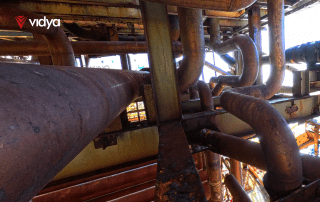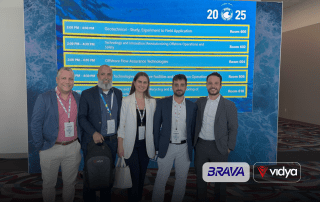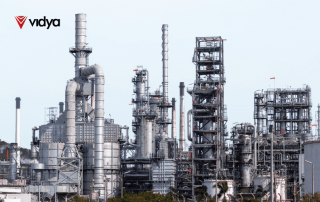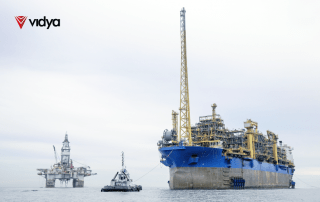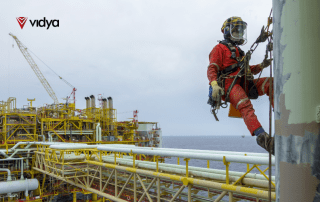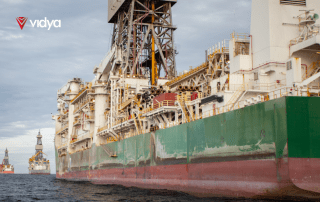Planning for the Unplanned: Why Temporary Repairs Matter More Than You Think
Temporary repairs are interim solutions applied to damaged or degraded equipment to maintain safety and functionality until a permanent repair can be executed. These kind of repairs are common in every industry where equipment operates under high pressure, temperature, or corrosive conditions, and shutting down operations for full replacement or overhaul isn’t always immediately feasible. Temporary repairs are not meant to last indefinitely, but can be strategic for avoiding production loss, mitigating safety risks, and buying time until a planned intervention can take place. Thus, when does a temporary repair become the safest move? Why Do Temporary Repairs Happen? [...]
Vidya and BRAVA Energia Present Paper at OTC Houston: A New Chapter in Corrosion and Integrity Management
This year, at the Offshore Technology Conference (OTC) in Houston, a new benchmark was set for offshore asset maintenance and corrosion control. Vidya, in collaboration with BRAVA Energia, presented a technical paper exploring a game-changing approach to the industry’s enduring challenge: reducing the risk of corrosion while optimizing operational efficiency in brownfields. Titled "Digitalization of the Corrosion Identification Process Using Digital Technologies in Mature Fields", the paper was co-authored by teams from Vidya and BRAVA Energia, including: Lincon D’Aquila, Integrity and Maintenance Manager at Brava, Otavio Correa, Vidya’s CEO, Jorge Mariano, Vidya’s VP US, and André Andrade, Marketing [...]
Regulatory Compliance in Asset Integrity: What You Need to Know
In large-process industries, entire facilities operate under conditions of high pressure, high temperature, and elevated risk. Within this context, regulatory compliance is not a bureaucratic obligation—it is a technical imperative. Asset integrity, safety, and operational continuity depend on how well facilities meet and maintain regulatory standards, particularly for pressure-retaining equipment and critical infrastructure. This blog explores why Asset Integrity requires regulatory compliance and how operations can benefit from being transparent and compliant. Why Asset Integrity Requires Regulatory Compliance Maintaining the structural integrity of equipment such as pressure vessels, storage tanks, and interconnecting piping systems is essential for mitigating [...]
Las 3 etapas de la Gestión de Integridad de Activos (AIM) en la Energia
La Gestión de la Integridad de Activos (AIM) es un dominio fundamental para las industrias de procesos a gran escala. Esta se refiere a la disciplina industrial que busca maximizar la eficiencia y confiabilidad de una planta de producción, incluyendo múltiples metodologías, sistemas y profesionales de distintas áreas. Este blog explora cómo los líderes de la industria abordan AIM, proponiendo una estructura paso a paso para implementar un programa sólido. No obstante, antes de comprender el estado actual de AIM, se cuestiona: ¿Cómo este dominio evolucionó hasta convertirse en un área tan compleja y específica? ¿Qué es la Gestión [...]
The 3 Stages of Asset Integrity Management in Energy
Asset Integrity Management (AIM) is a fundamental domain for large-process industries. It refers to the discipline that aims to maximize a production plant’s efficiency and reliability, involving multiple methodologies, systems, and various professionals and activities. This blog dives into how industry leaders approach AIM, encompassing a step-by-step structure to implement a robust program. Nonetheless, before understanding the current state of AIM, how did it evolve to such a complex and specific area? What is Asset Integrity Management? Asset Integrity Management (AIM) is the systematic approach to ensure the safety, reliability, and efficiency of industrial assets throughout their lifecycle. [...]
Understanding Asset Integrity Management and its Importance
Asset Integrity Management (AIM) refers to the discipline that aims to ensure industrial assets perform their functions accurately and efficiently throughout their lifecycle, all while maintaining safety and sustainability. In this context, a robust and effective asset integrity management program spans every stage, from asset design to decommissioning, aiming to mitigate risks to the environment, people on the field, and the industrial installation of which they are a part. This blog explores the major challenges of Asset Integrity Management and how the Oil and Gas industry is facing the digitalization of this important discipline. Signs of unoptimized asset [...]
How AI is Enhancing Wind Turbine Integrity
Wind turbines have become the symbol of clean energy production. As global priorities shift toward clean energy sources, the demand for wind power has rapidly increased in the last few years. Still, despite its ecological appeal, wind energy production faces limitations and challenges that require intricate processes and solutions, just like any other energy industry. Fortunately, technology advancements are helping the industry address these pressing issues and operate more sustainably and safely. In this manner, what defines those ‘’pressing issues’’ impacting wind energy operations? The Challenges of Wind Energy Operations As the demand for wind energy grows, so [...]
Condition-Based vs Reliability-Centered Maintenance
Condition-Based Maintenance and Reliability-Centered Maintenance are both popular and often confused concepts in Asset Integrity Management. Indeed, they share some common goals: minimizing downtime, reducing maintenance costs, and ensuring the reliability of critical assets. However, understanding the distinctions between these two approaches is crucial for any industry looking to optimize maintenance strategies. Condition-Based Maintenance (CBM) Condition-Based Maintenance consists of a predictive maintenance approach that analyzes the historical performance data of machines to forecast when one is likely to fail, limit the time it is out of service, and identify the root cause of the problem. The idea here [...]
Understanding Dropped Object Prevention for Energy Industries
In 2016, dropped objects from Offshore Oil facilities resulted in 255 worker fatalities in the United States, according to the Bureau of Labor Statistics, an alarming statistic that made clear the urgency of a curious, but important safety protocol that industries needed to adopt: fighting gravity. However, these incidents are far from inevitable and can be significantly reduced through a robust Dropped Object Prevention program. And, considering the scale and complexity of the energy industry’s operations, these programs became a fundamental piece of Industrial Safety and Risk Management. But what defines a Dropped Object? What is a Dropped Object? [...]
5 Essentials of Hull Damage Prevention for ships and FPSOs
Hull damages such as cracks and discontinuities can lead to oil leaks, implicating direct emergency costs surpassing USD 50,000,000, according to Brazil's National Petroleum Agency. From oil spills to accidents, the consequences of hull damage on oil and gas operations are far-reaching. Besides that, hulls are the exoskeleton of offshore units, requiring regular, accurate, and efficient maintenance procedures to address the excessive wear and tear, cracks, and anomalies that these structures are exposed to. Ensuring adequate maintenance and repairs demands inspection procedures that often require rope access techniques. Even though it is a common practice, it exposes inspectors to complex [...]
